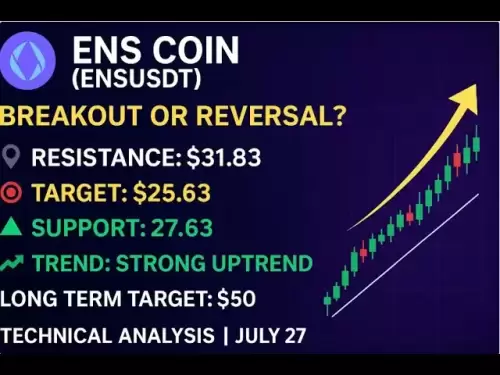-
 Bitcoin
Bitcoin $117900
0.31% -
 Ethereum
Ethereum $3766
0.28% -
 XRP
XRP $3.176
-0.31% -
 Tether USDt
Tether USDt $1.000
0.00% -
 BNB
BNB $795.6
1.51% -
 Solana
Solana $186.8
-1.09% -
 USDC
USDC $0.9999
-0.01% -
 Dogecoin
Dogecoin $0.2353
-1.33% -
 TRON
TRON $0.3226
1.49% -
 Cardano
Cardano $0.8172
-1.08% -
 Sui
Sui $4.178
3.06% -
 Hyperliquid
Hyperliquid $43.05
-3.39% -
 Stellar
Stellar $0.4367
-0.57% -
 Chainlink
Chainlink $18.62
1.47% -
 Hedera
Hedera $0.2828
6.63% -
 Bitcoin Cash
Bitcoin Cash $584.7
5.65% -
 Avalanche
Avalanche $24.81
2.53% -
 Litecoin
Litecoin $112.8
-0.88% -
 UNUS SED LEO
UNUS SED LEO $8.975
-0.08% -
 Shiba Inu
Shiba Inu $0.00001395
-1.07% -
 Toncoin
Toncoin $3.285
-1.05% -
 Ethena USDe
Ethena USDe $1.001
0.01% -
 Polkadot
Polkadot $4.123
0.76% -
 Uniswap
Uniswap $10.49
-0.18% -
 Monero
Monero $326.5
0.14% -
 Dai
Dai $0.9999
-0.02% -
 Bitget Token
Bitget Token $4.576
0.34% -
 Pepe
Pepe $0.00001247
-1.55% -
 Cronos
Cronos $0.1400
3.77% -
 Aave
Aave $295.1
-0.73%
What are the basic concepts and definitions of USDT?
USDT, a stablecoin pegged to the US dollar, aims for a 1:1 ratio but faces scrutiny regarding reserve transparency and the potential for de-pegging, impacting its use in trading, DeFi, and as a store of value.
Mar 05, 2025 at 04:12 pm
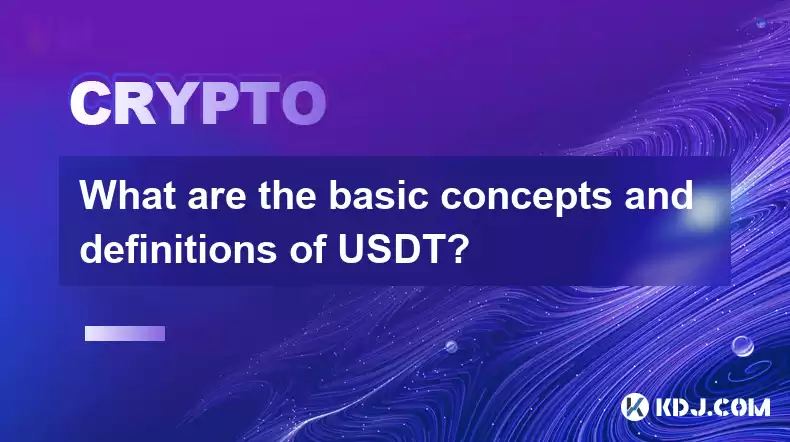
What are the basic concepts and definitions of USDT?
Key Points:
- USDT's Nature: USDT is a stablecoin pegged to the US dollar, aiming for a 1:1 ratio. This means one USDT should always be worth one US dollar. However, the actual value can fluctuate slightly depending on market conditions and the issuer's reserves. We will explore the mechanics of this pegging mechanism in detail.
- Issuance and Redemption: We will delve into the process of how Tether, the issuer, creates and destroys USDT tokens, highlighting the importance of backing assets and the transparency (or lack thereof) surrounding this process. This section will address concerns about the legitimacy and stability of USDT's backing.
- USDT's Use Cases: USDT's role in the cryptocurrency ecosystem is multifaceted. It serves as a medium of exchange, a store of value (albeit a controversial one), and a crucial tool in various DeFi applications. We will examine these use cases and their implications.
- Risks and Concerns: The history of USDT has been marked by controversies and scrutiny regarding its reserves and transparency. We will address these concerns, exploring the potential risks associated with holding and using USDT. This includes potential de-pegging events and regulatory uncertainty.
- Alternatives to USDT: The cryptocurrency market offers alternative stablecoins, each with its own strengths and weaknesses. We will briefly discuss some of these alternatives and compare them to USDT.
Unordered List of Detailed Explanations:
- Understanding the Nature of USDT and its Pegging Mechanism:
USDT, or Tether, is a cryptocurrency designed to maintain a stable value pegged to the US dollar. The core concept is simple: one USDT should always be worth one USD. However, the reality is far more complex. Tether Limited, the company behind USDT, claims to hold reserves of US dollars and other assets equivalent to the number of USDT in circulation. This is the theoretical basis for the peg. In practice, maintaining this 1:1 ratio is a constant challenge. Market forces, investor sentiment, and the transparency of Tether's reserves all play a crucial role. Fluctuations in the value of USDT, though often minor, do occur. These fluctuations can be amplified during periods of market volatility or uncertainty surrounding Tether's operations. The company publishes regular "attestations" of its reserves, though these have been subject to intense scrutiny and criticism, with concerns raised about the nature and liquidity of the assets held. The pegging mechanism itself is largely opaque, relying on the company's internal processes and the trust placed in its claims. Understanding the inherent limitations and potential risks associated with this mechanism is critical for anyone considering using USDT. The complexities of maintaining a stablecoin pegged to a fiat currency in a volatile cryptocurrency market are significant, and the effectiveness of Tether's approach remains a subject of ongoing debate and investigation. This includes the potential for a "bank run" scenario, where a large number of users attempt to redeem their USDT for USD simultaneously, potentially overwhelming Tether's ability to fulfill those redemption requests. The potential for a de-pegging event, where the value of USDT falls significantly below one USD, is a significant risk factor for investors.
- The Issuance and Redemption Process of USDT:
The creation and destruction of USDT tokens is a critical aspect of its functionality. Tether Limited, the issuer, controls this process. When USDT is issued, Tether claims to add an equivalent amount of USD or other assets to its reserves. This process ideally ensures that there are sufficient reserves to back every USDT token in circulation. However, the lack of complete transparency surrounding these reserves raises concerns. Audits have been inconsistent and often fall short of providing the level of detail needed to fully verify the company's claims. The redemption process, where users exchange USDT for USD, is also crucial. Theoretically, this process should be straightforward, with users able to redeem their USDT at a 1:1 ratio. However, delays or difficulties in redemption could indicate problems with Tether's reserves or operational capacity. The efficiency and transparency of both issuance and redemption are vital for maintaining trust in the stability of USDT. Concerns about the potential for manipulation or fraud in these processes have been raised repeatedly. The lack of a fully auditable and transparent system for tracking the flow of assets between Tether's reserves and the USDT in circulation remains a major point of contention. Understanding the mechanics of issuance and redemption, along with the associated risks and lack of transparency, is crucial for assessing the overall stability and reliability of USDT. The process relies heavily on trust in Tether's claims and the effectiveness of its internal controls, making it vulnerable to criticism and potential regulatory action.
- USDT's Diverse Applications within the Cryptocurrency Ecosystem:
USDT plays a multifaceted role within the cryptocurrency ecosystem. Its primary function is as a stable medium of exchange. Unlike volatile cryptocurrencies like Bitcoin or Ethereum, USDT provides a relatively stable unit of account, facilitating trading and transactions within the crypto space. This allows traders to avoid the price volatility associated with other cryptocurrencies, making it easier to manage risk and execute trades. USDT also serves as a store of value, albeit a controversial one given the concerns about its backing. Many investors use USDT as a temporary holding place for their funds, particularly during periods of market uncertainty. This use case, however, relies heavily on the assumption that the peg to the US dollar will remain stable. Beyond trading and holding, USDT is increasingly integrated into decentralized finance (DeFi) applications. It is used as collateral in lending and borrowing protocols, providing a stable asset for borrowers and lenders. It also fuels liquidity pools in decentralized exchanges (DEXs), enabling the trading of various cryptocurrencies. The use of USDT in DeFi expands its functionality beyond simple trading, highlighting its importance in the broader crypto ecosystem. However, this also increases the potential impact of any problems with USDT's stability on the DeFi ecosystem as a whole. The widespread adoption of USDT in these various applications underlines its significance but also underscores the systemic risks associated with its potential failure.
- Risks and Concerns Surrounding USDT:
Despite its widespread use, USDT is not without its risks and concerns. The most significant concern revolves around the transparency and legitimacy of its reserves. The lack of consistent and comprehensive audits raises questions about the actual assets backing the USDT in circulation. This lack of transparency creates uncertainty and undermines trust, making investors vulnerable to potential losses if the peg to the USD were to break. Furthermore, the regulatory landscape surrounding stablecoins remains uncertain. Governments worldwide are increasingly scrutinizing stablecoins, potentially leading to stricter regulations or even bans. This regulatory uncertainty adds another layer of risk for USDT holders. The potential for a "bank run," where a large number of users simultaneously attempt to redeem their USDT, poses a significant threat to the stability of the system. If Tether were unable to meet the redemption requests, the value of USDT could plummet, causing significant losses for investors. The interconnectedness of USDT with the broader cryptocurrency ecosystem also means that any problems with USDT could have wider repercussions. Its use in DeFi applications, for example, makes it a systemic risk factor. Understanding these risks and concerns is crucial for anyone considering using or investing in USDT. The lack of complete transparency and the potential for regulatory intervention make it a relatively high-risk asset compared to traditional fiat currencies.
- Exploring Alternative Stablecoins:
The cryptocurrency market offers a range of alternative stablecoins, each with its own characteristics and mechanisms for maintaining stability. Some are pegged to the US dollar, while others are pegged to other assets or use algorithmic approaches to maintain stability. These alternatives often offer different levels of transparency and regulatory oversight. Comparing these alternatives to USDT is crucial for investors seeking a more secure or transparent stablecoin option. Some alternatives might offer greater transparency in their reserve management or utilize more robust auditing processes. Others might be subject to different regulatory frameworks, potentially offering a higher degree of legal certainty. However, each alternative also comes with its own set of risks and potential limitations. The choice of which stablecoin to use depends on individual risk tolerance and investment strategies. It is essential to research and understand the specific mechanisms and risks associated with each stablecoin before making any investment decisions. The landscape of stablecoins is constantly evolving, with new options and innovations emerging regularly. Staying informed about the latest developments is critical for navigating this complex and dynamic market.
FAQs:
Q: What exactly backs USDT?
A: Tether claims that USDT is backed by a combination of US dollars, commercial paper, secured loans, and other assets. However, the exact composition and details of these reserves have been a source of controversy and criticism due to a lack of consistent and fully transparent audits.
Q: Is USDT safe?
A: The safety of USDT is a complex question. While it has generally maintained its peg to the US dollar, the lack of complete transparency regarding its reserves and the potential for regulatory intervention introduce significant risks. There is a risk of de-pegging and potential losses for investors.
Q: How does USDT differ from other stablecoins?
A: USDT is one of the oldest and most widely used stablecoins, but it differs from others in terms of transparency, the nature of its backing assets, and the regulatory scrutiny it faces. Other stablecoins may offer greater transparency or utilize different mechanisms for maintaining stability.
Q: What are the potential consequences of a USDT de-pegging event?
A: A de-pegging event could have significant consequences for the cryptocurrency market, particularly for the DeFi ecosystem where USDT is widely used. It could lead to cascading liquidations, widespread losses, and a significant loss of confidence in the entire stablecoin market.
Q: Is USDT regulated?
A: The regulatory status of USDT varies across different jurisdictions. While it is not explicitly regulated in some regions, it faces increasing scrutiny and potential regulatory action from various governments worldwide. The regulatory landscape is constantly evolving.
Q: Should I invest in USDT?
A: Whether or not to invest in USDT is a personal decision that depends on your individual risk tolerance and investment goals. Given the controversies surrounding its reserves and the inherent risks associated with stablecoins, it is crucial to conduct thorough research and carefully consider the potential downsides before investing.
Disclaimer:info@kdj.com
The information provided is not trading advice. kdj.com does not assume any responsibility for any investments made based on the information provided in this article. Cryptocurrencies are highly volatile and it is highly recommended that you invest with caution after thorough research!
If you believe that the content used on this website infringes your copyright, please contact us immediately (info@kdj.com) and we will delete it promptly.
- Bitcoin, Ruvi AI, and CoinMarketCap: Navigating the Future of Crypto
- 2025-07-28 02:30:12
- Dogwifhat (WIF) Eyes Bullish Breakout: Can It Breach $1.20?
- 2025-07-28 02:50:12
- Bitcoin Bounces: How the US-China Tariff Truce Impacts Crypto
- 2025-07-28 02:50:12
- Bitcoin Bull Market: Price Targets and Expert Takes
- 2025-07-28 02:30:12
- Cardano Price Rockets: ADA Jumps Past Resistance, $2 Target in Sight?
- 2025-07-28 01:30:14
- Ruvi AI: The Next Solana? Riding the AI Token Wave on CoinMarketCap
- 2025-07-28 00:50:16
Related knowledge

How to choose a reliable USDT exchange service provider? How to identify?
Jun 12,2025 at 03:15pm
Understanding the Role of USDT in Cryptocurrency TradingUSDT (Tether) is one of the most widely used stablecoins in the cryptocurrency market. It is d...
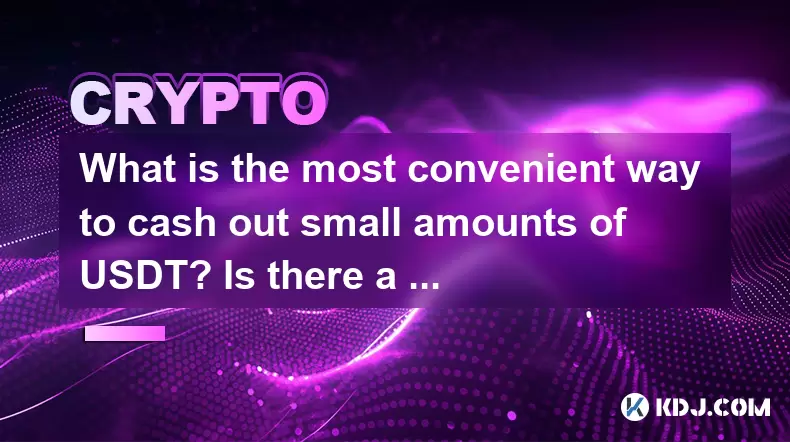
What is the most convenient way to cash out small amounts of USDT? Is there a shortcut?
Jun 11,2025 at 11:00pm
Understanding the Need to Cash Out Small USDT AmountsCashing out small amounts of USDT can be a challenge for many crypto users. Traditional methods o...
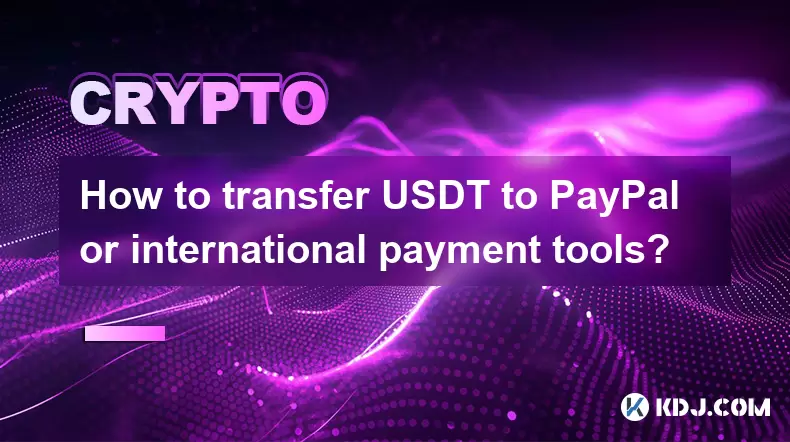
How to transfer USDT to PayPal or international payment tools?
Jun 15,2025 at 05:28am
Understanding the Basics of USDT and PayPal IntegrationUSDT (Tether) is a stablecoin pegged to the US dollar, offering blockchain-based value transfer...
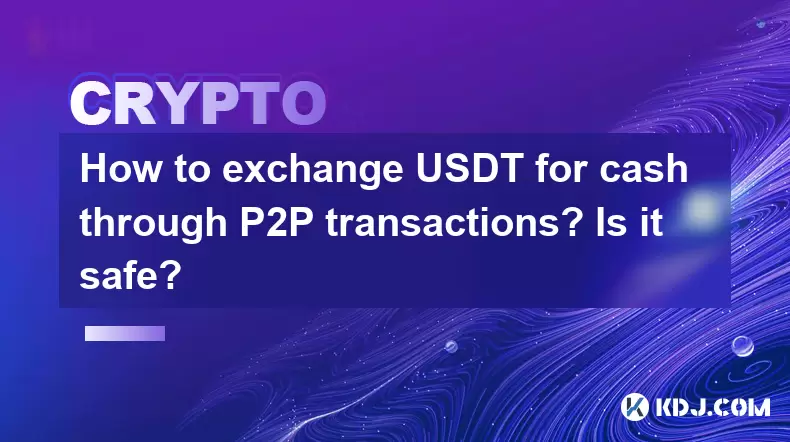
How to exchange USDT for cash through P2P transactions? Is it safe?
Jun 18,2025 at 07:56am
Understanding USDT and P2P TransactionsTether (USDT) is a stablecoin pegged to the value of the US dollar, making it a popular choice for users who wa...
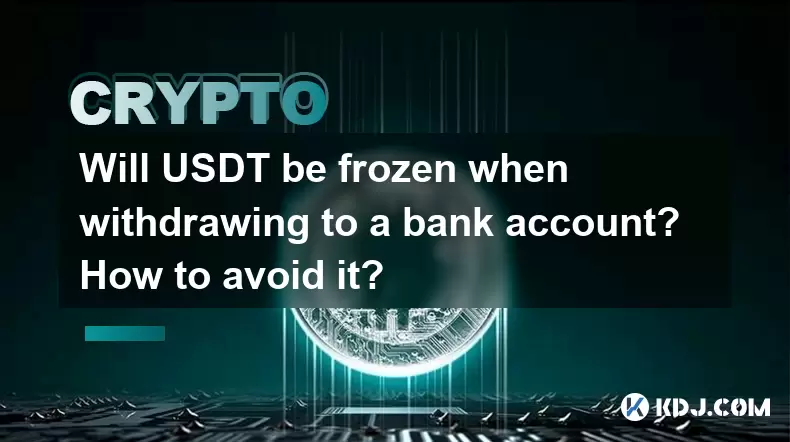
Will USDT be frozen when withdrawing to a bank account? How to avoid it?
Jun 15,2025 at 10:03am
Understanding USDT Withdrawals and Bank Account Freezing RisksWhen users decide to withdraw USDT (Tether) to a bank account, one of the most common co...
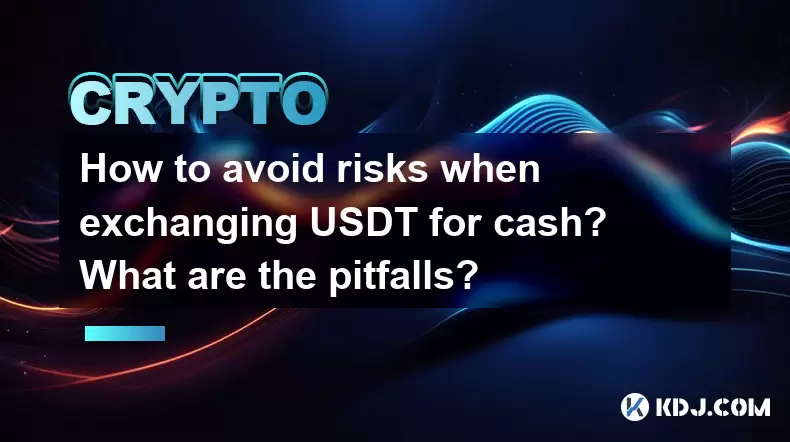
How to avoid risks when exchanging USDT for cash? What are the pitfalls?
Jun 11,2025 at 08:14pm
Understanding the Risks of Exchanging USDT for CashWhen exchanging USDT (Tether) for cash, users must be aware of the potential risks involved. As a s...

How to choose a reliable USDT exchange service provider? How to identify?
Jun 12,2025 at 03:15pm
Understanding the Role of USDT in Cryptocurrency TradingUSDT (Tether) is one of the most widely used stablecoins in the cryptocurrency market. It is d...

What is the most convenient way to cash out small amounts of USDT? Is there a shortcut?
Jun 11,2025 at 11:00pm
Understanding the Need to Cash Out Small USDT AmountsCashing out small amounts of USDT can be a challenge for many crypto users. Traditional methods o...

How to transfer USDT to PayPal or international payment tools?
Jun 15,2025 at 05:28am
Understanding the Basics of USDT and PayPal IntegrationUSDT (Tether) is a stablecoin pegged to the US dollar, offering blockchain-based value transfer...

How to exchange USDT for cash through P2P transactions? Is it safe?
Jun 18,2025 at 07:56am
Understanding USDT and P2P TransactionsTether (USDT) is a stablecoin pegged to the value of the US dollar, making it a popular choice for users who wa...

Will USDT be frozen when withdrawing to a bank account? How to avoid it?
Jun 15,2025 at 10:03am
Understanding USDT Withdrawals and Bank Account Freezing RisksWhen users decide to withdraw USDT (Tether) to a bank account, one of the most common co...

How to avoid risks when exchanging USDT for cash? What are the pitfalls?
Jun 11,2025 at 08:14pm
Understanding the Risks of Exchanging USDT for CashWhen exchanging USDT (Tether) for cash, users must be aware of the potential risks involved. As a s...
See all articles
























